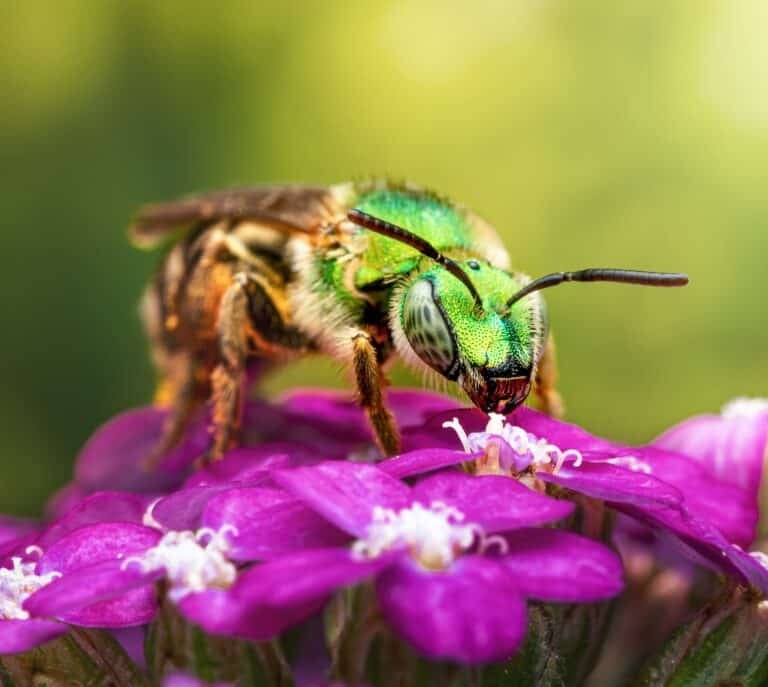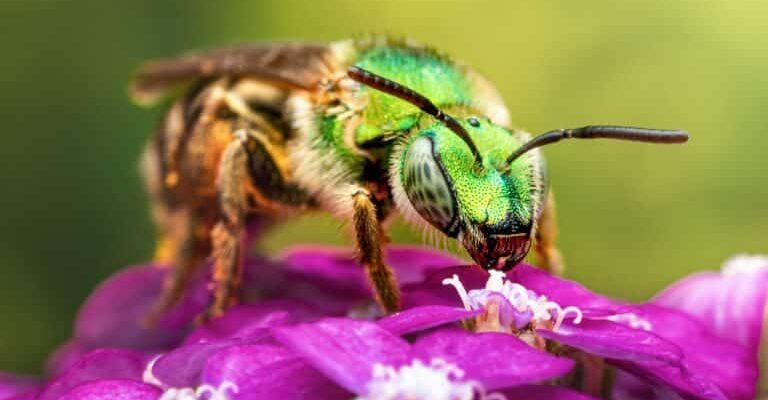
You might be wondering why these little bees are so important. Well, for gardeners and farmers, sweat bees offer a lot more than just a cute buzz. By understanding their role and benefits, you can appreciate Gardeners’ best-kept secret. So, let’s dive into the world of sweat bees and discover what makes them the ultimate allies for anyone looking to cultivate a thriving garden or farm.
What Are Sweat Bees?
Before diving into their benefits, let’s get to know the sweat bee a bit better. Sweat bees, belonging to the family Halictidae, are small, often metallic-looking bees. They get their name because they’re attracted to human sweat, especially when we’re out enjoying a sunny day in the garden. While they may not produce honey like honeybees, don’t underestimate their impact.
There are over 1,000 species of sweat bees in North America, varying in size, color, and behavior. Some are solitary, while others are social, living in small groups. Their adaptability allows them to thrive in different environments, from urban gardens to rural farmlands. So, when you see one buzzing nearby, remember that it’s not just passing through—it’s potentially on a mission to help your plants grow.
Exceptional Pollination Power
One of the primary benefits of sweat bees is their pollination prowess. They’re particularly effective on crops that require cross-pollination. Unlike honeybees, which tend to stick to one type of flower during a foraging trip, sweat bees visit various flowers in quick succession. This means they can facilitate cross-pollination between different plants more efficiently.
But why does this matter? Well, when plants receive proper pollination, they have a better chance of producing healthy fruits and seeds. For gardeners, this means bigger tomatoes, juicier berries, and vibrant flowers. Farmers can see an increase in crop yields, which translates to better harvests and potentially more profit. Talk about a win-win!
Low Maintenance Allies
Another fantastic aspect of sweat bees is that they require minimal maintenance. Unlike other pollinators, like honeybees, which need a hive and regular care, sweat bees can thrive without much human intervention. You might be thinking, “Well, that sounds easy!” And you’re right!
To attract sweat bees, you don’t need elaborate hives or complex arrangements. Just plant a variety of flowers and let nature do its thing! They love native plants, herbs, and even some vegetables. By creating a diverse garden, you’ll naturally invite these bees to take up residence, providing you with free pollination services without the hassle.
Supporting Biodiversity
Encouraging sweat bees in your garden is also beneficial for biodiversity. By fostering an environment where these bees can thrive, you’re supporting a healthy ecosystem. Biodiversity helps maintain the balance of nature, ensuring that various plant and animal species can coexist.
When sweat bees are present, they contribute to the health of other pollinator populations. A thriving community of bees means better pollination for various plants, leading to a more resilient garden. And let’s be honest—who wouldn’t want a more vibrant and lively outdoor space?
Nesting Preferences: A Garden-Friendly Choice
Sweat bees have unique nesting habits that make them a great fit for gardens. Many species prefer to nest in the ground, often in sandy or well-drained soil. This is a plus for gardeners because they won’t usually invade your home or structures. Instead, they’ll go about their business where they feel most at home—beneath your perennials or in the patches of earth that you might not even think about.
Creating a garden that welcomes sweat bees means allowing a bit of wildness. Leaving areas untouched or mulching lightly can encourage them to set up shop. So, instead of worrying about “messy” spots in your garden, think of them as potential bee hotels!
Natural Pest Control
An added bonus of having sweat bees around is their role in natural pest control. While they’re mainly known for pollination, some sweat bees also feed on pest insects. This can help keep pesky pests, like aphids, in check, reducing the need for chemical pesticides that can harm beneficial insects.
By maintaining a balance, sweat bees contribute to a healthier garden ecosystem. The more balanced your garden, the less work you’ll have to do in the long run. It’s like having a tiny army of helpers who work hard without asking for anything in return.
Creating a Sweat Bee-Friendly Environment
So, how can you create a habitat that attracts sweat bees? Here are some simple steps to start:
- Plant Native Flowers: Choose a variety of native plants, including wildflowers, to provide diverse food sources.
- Avoid Pesticides: Reduce or eliminate pesticide use to keep your garden safe for bees and other beneficial insects.
- Provide Water: A shallow dish of water can attract sweat bees, especially on hot days. Be sure to change it regularly!
- Leave Bare Soil: Letting patches of bare soil remain can encourage nesting. Just a few square feet can make a big difference!
By following these tips, you can create a welcoming garden that thrives with the help of sweat bees.
Sweat bees may be small, but their contributions to gardening and farming are significant. From superb pollination to supporting biodiversity, they provide a natural solution that benefits the ecosystem while boosting your plants’ health. By welcoming these tiny allies into your garden, you stand to enjoy richer harvests, vibrant blooms, and a thriving outdoor space.
In the end, fostering a relationship with sweat bees is about nurturing nature’s little helpers. So next time you see one buzzing nearby, remember you’re not just looking at a tiny bee. You’re witnessing a crucial part of your garden’s success story, making every sweat bee worth its weight in gold.

